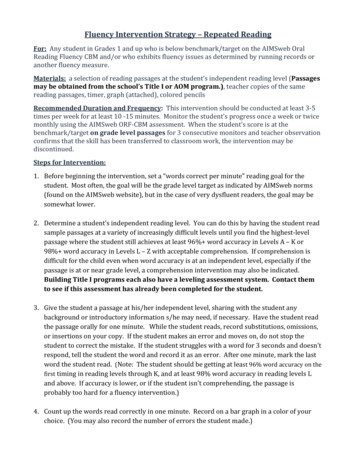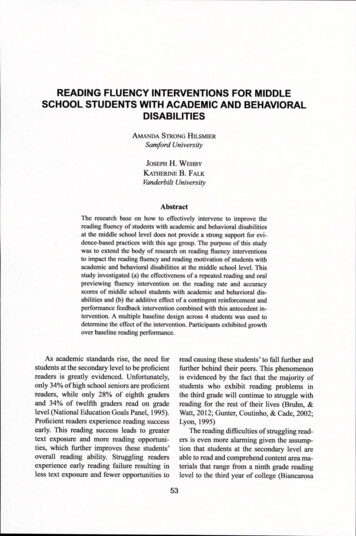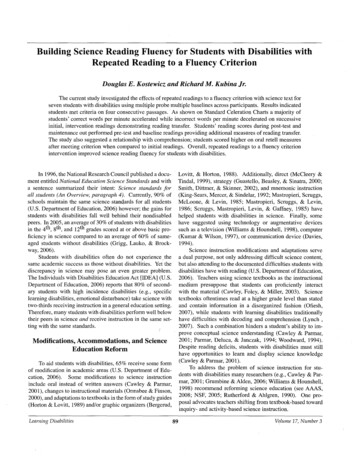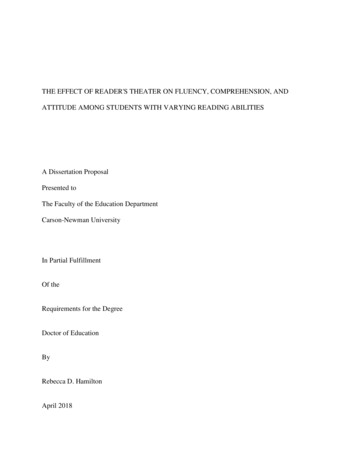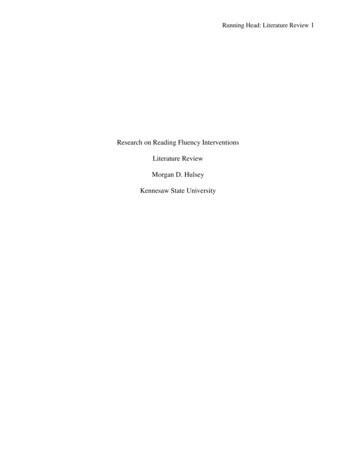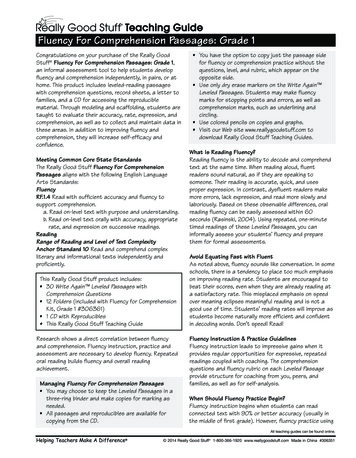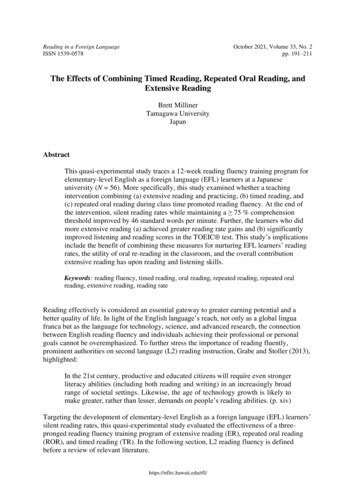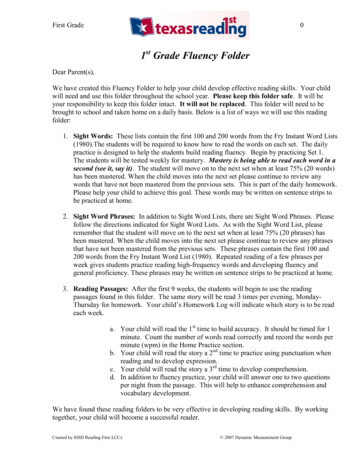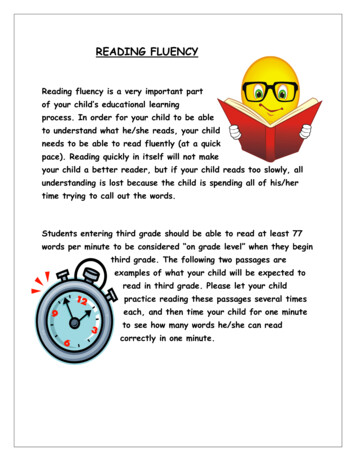
Transcription
READING FLUENCYReading fluency is a very important partof your child’s educational learningprocess. In order for your child to be ableto understand what he/she reads, your childneeds to be able to read fluently (at a quickpace). Reading quickly in itself will not makeyour child a better reader, but if your child reads too slowly, allunderstanding is lost because the child is spending all of his/hertime trying to call out the words.Students entering third grade should be able to read at least 77words per minute to be considered “on grade level” when they beginthird grade. The following two passages areexamples of what your child will be expected toread in third grade. Please let your childpractice reading these passages several timeseach, and then time your child for one minuteto see how many words he/she can readcorrectly in one minute.
READING COMPREHENSIONAlong with reading fluency, students need tounderstand what they read. In third grade,students are expected to achieve mastery ofall Reading skills by scoring a 70% or higherfor each skill. An EXTREMELY importanttool that you can encourage your child touse is to go back into the story after it hasbeen read and underline where your child findsthe answer. By asking him/her to do this, you canensure that your child is actually reading the story.The following stories are examples of what your child will see nextyear in third grade. Have your child read each story, underlinewhere they found the answers, and answer each question.
Fishing Fun"Beep! Beep! Beep!" roared the alarm clock. Juanita turned the alarm off and lookedat the clock. She closed her eyes and wondered why she had to wake up at 4:00 A.M.to go fishing. "Juanita! Wake up!"Juanita rolled out of bed quickly and got dressed. As she and Uncle Jack walked outthe door, Juanita's mom handed her two bags. "One is for breakfast, the other is forlunch," she said and kissed her on the cheek.In the truck Juanita asked Uncle Jack a million questions. "What kind of fish will wecatch? When will we be at the lake? What will we use to catch the fish?" Because it wasJuanita's first fishing trip, Uncle Jack calmly answered each question.Finally, they arrived at Lake West Point and put on their lifejackets. As they got in theboat, Uncle Jack gave Juanita her first fishing job—untying the boat from the dock. Sheput one foot up on the edge of the boat. Plop! Into the water went one of the bags. "Ohno! Our lunch is gone!" Juanita cried.But she soon forgot about the lost lunch. Uncle Jack found the perfect fishing spot.He showed Juanita how to bait the hook and throw the line into the water. Faster thanyou can say "catfish," Uncle Jack caught a fish. "You will get your turn," said UncleJack.A strong wind began to blow. "Uncle Jack, do you think it is going to " Juanita'squestion was interrupted by a tug on her line. She had caught a fish! She could not waitto compare her fish to Uncle Jack's fish.Imagine her surprise when her hard work only brought up plants from the lake!"Fishing is fun," Uncle Jack said with a wink of his eye.Before Juanita could answer, the sky opened and hard rain fell."So, Uncle Jack," Juanita asked, "is fishing always this much fun?" Uncle Jacklaughed as he handed Juanita a raincoat.1)Which statement is probably true about how people all over the world catch fish?a)b)c)d)2)They use the same type of fishing bait as Juanita.They stop fishing when it starts to rain.They get up at the same time to catch fish.They use some type of pole or tool to catch fish.What is the meaning of the prefix in the underlined word?untying the boat from the docka)opposite ofb)againc)afterd)for
3)What did Juanita's mom do that showed she cared for her daughter?a)b)c)d)She gave her food for breakfast and lunch.She reminded her to wear a lifejacket.She made sure she had a raincoat.She gave her a fishing pole to use.How Animals TalkAll living things send messages. People talk face-to-face, write letters, and makephone calls. They also use "body talk," like smiling to say, "I am pleased," or shiveringto say, "I am cold."Animals send messages to each other too. They make sounds, leave smells, and actin special ways. By doing these things animals warn of danger, set rules for leadership,and tell other animals they have found food. For example, when a male deer rubsagainst trees to leave his smell, he tells other deer to stay out of his space. White-taileddeer flick their tails up in the air as if to say, "Run!" so other deer can escape danger.Swallowtail caterpillars give off a stinky smell to keep enemies away. Young owls peckat the adults to ask for food. Bull elk crash their antlers together to see who is boss.Even underwater living things send messages. Manatees touch whiskers, chirp, andsqueak to say hello. Messages, sent by people or animals, help living things survive,grow, and talk with each other.4)Why does a swallowtail caterpillar give off a stinky smell?a)c)5)to ask for foodto keep enemies awayb)d)danger, smell, touchsmiling, whiskers, warnWhat kind of passage is How Animals Talk?a) fiction7)to leave his scentto see who is bossWhich three words from the passage name things animals do to sendmessages?a) peck, squeak, rubc) owls, caterpillars, elk6)b)d)b)poetryc)dramad)nonfictionWhat might a manatee do to escape danger?a)c)flick its tail in the airmake a chirping soundb)d)touch whiskers with its enemyrub its smell against a tree
8)How does the message a white tailed deer sends help the other deer survive?a)b)c)d)9)It helps them make new friends.It tells them where to find food.It tells them to stay out of its space.It warns them to run from danger.Which homework assignment might the passage help you with?a)b)c)d)10)List five ways animals escape danger.List five animals and tell where they live.List four ways animals send messages to each other.List four sounds people make when they send messages.Which is a way that real animals talk?a)c)by writing storiesby drawing picturesb)d)by sending e-mailsby using their bodiesState Fair Food MenuSusan and Thomas were spending the day at the State Fair. Around 12:30 p.m., theybegan to get hungry. They decided to have some lunch. Below is the menu from the fairwhere they were going to get something to eat.11)Which of these can Susan buy at the fair?a)potato chipsb)fresh fruitc)soupd)pizza
12)What do the marks ** after the heading Sandwiches mean?a)b)c)d)13)Which sentence tells you why Susan and Thomas would want to read the menu?a)b)c)d)14)Below is the menu from the fair.Around 12:30 p.m., they began to get hungry.Susan and Thomas were spending the day at the fair.All sandwiches come with slices of pickles, onions, and tomatoes.What can you conclude after reading the State Fair Food Menu?a)b)c)d)15)The sandwiches are: Hot Dog, Hamburger, Corndog, and Grilled CheeseAll sandwiches come with slices of pickles, onions, and tomatoes.All sandwiches come with French Fries, a drink, and a dessert.The sandwiches range in price from 1.25 to 2.25.Susan and Thomas are best friends.Susan and Thomas like the food at the fair.Susan and Thomas had to be home before 9:00 p.m.Susan and Thomas arrived at the fair before 12:30 p.m.Thomas bought four items. It is very hot outside. What item should Thomas eatFIRST?a) french fries16)b) ice creamc) hot dogd) ice teaWhich item from the menu includes tomatoes?a) coleslawb) granola barc) hamburgerd) juice
MATHThird grade math standards requirethat your child be able to problemsolve and come up with answers tovarying types of questions. Yourchild MUST know the multiplicationfacts and must be able to read well since nearly allMath problems are now presented inword problem form. The followingMath problems are examples of whatyour child will be required to donext year.
1)The third-grade students sold 292 candy bars. The equation shown can beused to find the number of candy bars, x , sold by the fourth-gradestudents.X 15 292How many total candy bars did the third and fourth grade students sell?a. 2772)b.307c.569d.599Amy lined up the cards shown for a memory game.Which equation correctly shows 2 ways to find the total number of cardsAmy lined up for the memory game?a.b.3)5 x 8 (5 4) x (5 4)5 x 8 (5 4) (5 4)b. 5 x 8 (5 x 4) x (5 x 4)d. 5 x 8 (5 x 4) (5 x 4)Armando separated the figure shown into equal parts.Which expression represents the shaded part of the figure?a.b.c.d.1/8 1/82/8 2/81/8 1/8 1/8 1/8 1/8 1/8 1/8 1/82/8 2/8 2/8 2/8 2/8 2/8 2/8 2/8
4)Your mother gave you 3.00 to spend for a healthy snack of fruit. Show one combinationof fruit that you can buy with the 3.00. You can use a fruit more than once. Use therecording chart below.FruitHow many?PriceTOTAL:5)Kimberly told Karen that she has about 70 gumballs. Karen has 68 gumballs. Knowing thatKimberly rounded her total, is it possible that Karen has more gumballs than Kimberly?Justify your thinking using words, pictures and numbers.6)There is a tree with three branches. On each branch there are seven nests. In each nestthere are four eggs. How many eggs are there in all? Draw a picture if you need to.Complete the following patterns:7)24, 30, 36,8)18, 23, , 339)93, 85, 77,10)54, 50, , 4211)Explain what is wrong with the following:4,000 800 4 484
12)Thomas had to run 25 miles during a race. He ran 17 miles yesterday. How many milesdoes Thomas still have to run?Did you add or subtract in the above problem? How did you know whatto do?Estimate the sums and differences.13)462 38816)14)92315)- 259211 846Heaven saw 53 fish in the pond on Saturday. Mary Alyssa saw 75 fish in a different pondon Saturday. Which number sentence shows how many fish they saw in all?75 - 53 53 75 53 75- 75 53Explain why your answer is correct.17)18)19)Haley went to the grocery store and bought a bag of apples for 4.75, some popcorn for 2.83, and a bag of cookies for 1.73. About how much money did Haley spend at thestore? (HINT: Round to the nearest dollar).Mrs. Wilson graded 79 papers on Wednesday, Miss Taylor graded 96 papers onWednesday, and Mrs. Roach graded 207 papers on Wednesday. How many papers weregraded altogether?Which statement below explains why 4,285 rounds to 4,300.A)B)C)D)4,285 is closer to 4,000 than 5,000.4,285 is closer to 4,000 than 4,5004,285 is closer to 5,000 than 4,3004,285 is closer to 4,300 than 4,200
20)Which statement below explains what you would do to solve the following wordproblem.Timothy has to travel 415 miles on his vacation trip. He has already traveled 325 miles.How many more miles does Timothy still need to travel?A)B)C)D)Timothy has to travel 415 miles and he has traveled 325 miles so you would addthe numbers.Timothy has to travel 415 miles and he has traveled 325. He still has some milesto travel so you would subtract the miles that he has already traveled to find outwhat he has left to travel.Timothy has to travel 415 miles so you would divide 415 miles by the 325 milesthat he has already traveled.None of the above statements are correct.Find the missing sum.21)7 2322)9 2423) 6 1624) 13 4825)Sophie spent 43 minutes playing with her friend, Betsy. Afterwards, she spent 59 minutesplaying with her friend, Carla. Choose the following number sentence that shows how toestimate the total number of minutes Sophie spent playing with her friends.A) 50 5026)29)60 3050 60 90B) 60 – 30C) 70 20D) 70 – 20B) 40 70 90C) 50 70 90D) 40 70 100How many tens are in 100? (Write it out if you need to.)2 (4 8) ?A) (2 4) 830)D) 40 60On vacation, Thomas drove 48 miles on Monday, 62 miles on Tuesday, and 93 miles onWednesday. Choose the following number sentence that shows how to estimate the totalnumber of miles Thomas drove.A)28)C) 40 50Brad had 63 baseball cards. He gave 27 of his baseball cards to his friend, Sam. Choosethe following number sentence that shows how to estimate the number of baseball cardsBrad had left.A)27)B) 50 60B)(6 4) 8C)2 (6 8)D) (2 2) 8Which expression is NOT the same as 3 x 4?A) 3 3 3 3B) 4 x 3C)4 4 4D) 3 x 3 x 3 x 3
MATH FACT FLUENCYMath fluency refers to how quickly your child can dohis/her math facts. It is important for your child toknow addition, subtraction, and multiplication factsquickly because all areas of Math are developedfrom these basic computation skills. In order foryour child to be successful with Algebra, Geometry,Measurement, Estimation, etc. your child needs tobe fluent in these basic Math facts. It is very easyto create your own flash cards or they may bepurchased at a very inexpensive price at such storesas The Dollar Tree or Dollar General. The followingpages are samples of timed math fact assessmentsthat your child will be required to do in 3rd grade.At the end of 3rd grade, your child should be ableto correctly answer 70 addition facts, 65subtraction facts, and 65 multiplication facts in 3minutes.
6 4 5 4 6 8 7 7 7 4 8 2 1 6 5 1 1 7 2 1 1 7 5 8 7 8 6 5 4 4 7 4 4 3 5 3 6 3 1 4 2 6 1 2 8 3 8 6 7 2 7 6 6 6 5 2 6 7 2 2 8 4 3 5 1 8 1 3 5 8 5 1 8 2 4 8 4 3 5 4 6 3 1 1 3 3 7 2 8 3 5 7 7 3 5 5 7 8 6 5 8 8 3 2 1 6 2 3 1 3 8 1 7 5 7 3 4 2 5 2 8 3 8 4 3 2 2 4 8 5 2 5 3 3 6 2 1 7 4 7 2 7 7 6 2 2 5 5 8 2 7 3 5 1 5 4 2 8 6 5 6 5 3 5 6 1 5 1 3 7 3 1 6 7 1 2 4 6 7 2 4 7 1 6 8 7 4 4 2 1 5 7 7 5 6 8 7 1
13 - 8 13 - 9 12 - 8 16 - 8 14 - 8 17 - 8 15 - 9 11 - 9 15 - 8 12 - 9 10 - 9 14 - 9 9-8 18 - 9 10 - 8 16 - 9 11 - 8 17 - 9 12 - 9 17 - 8 15 - 9 10 - 9 14 - 9 13 - 8 11 - 9 17 - 9 11 - 8 16 - 9 12 - 8 18 - 9 13 - 9 9-8 14 - 8 16 - 8 15 - 8 10 - 8 12 - 6 16 - 8 10 - 8 13 - 9 11 - 8 15 - 8 9-8 16 - 9 13 - 8 17 - 8 14 - 8 18 - 9 17 - 9 14 - 9 11 - 9 10 - 9 12 - 9 15 - 9 12 - 8 10 - 8 18 - 9 17 - 8 11 - 8 13 - 9 17 - 9 14 - 9 16 - 9 10 - 9 11 - 9 15 - 9 12 - 9 14 - 8 9-8 13 - 8 15 - 8 16 - 8 16 - 9 17 - 9 17 - 8 14 - 9 9-8 10 - 8 13 - 8 12 - 8 16 - 7 14 - 8 18 - 9 11 - 8 12 - 9 15 - 8 11 - 9 10 - 9 13 - 9 15 - 9 15 - 7 10 - 9 14 - 9 12 - 8 11 - 8 16 - 8 14 - 8 13 - 9 17 - 8
3x9 1x0 4x1 0x4 5x7 9 2 8 2 7 4 6 1 9 9 6 9 8 4 8x8 7x2 8x0 6x1 7x 5 5x6 7 3 9 3 9 1 0 9 2x8 4x0 9x8 9x6 2x9 5x5 2 4 2 0 9x4 3x4 6x8 3 5 3 9 1 4 3x1 3x5 2x3 3x7 8x1 3 7 9 3 4 5 6 2 5 8 5x1 8x1 7x6 5x0 5 x 2 8 3 4 5 0 2 6 5 7 64 x9 8x6 6x4 4x9 7 x 4 1 6 8 6 9 5 2 4 7x7 6 7 4x2 1x5 0x3 6x0 4x6 8 7 9 5 2 1 7 3 3 4 7x4 2x0 3x8 6x8 5x2 8 0 8 6 0 2 0 1 0 0 4x9 6x3 1x 9 3x7 7x0 5x6 6 x6 9x4 6x7 7x8 2x9 4x7
READING FLUENCY Reading fluency is a very important part of your child’s educational learning process. In order for your child to be able to understand what he/she reads, your child needs to be able to read fluently (at a quick pace). Reading quickly in itself will not make your child
